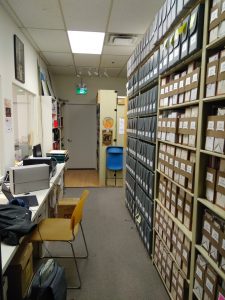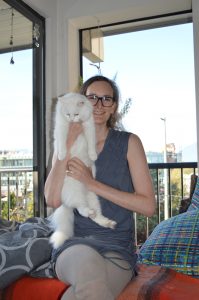Since starting my research at VIVO in August I have learnt to not set expectations. Let me rephrase this, I have learnt how to approach situations without expecting a specific outcome. With this outlook I am able to experience a new environment with fresh eyes.
I was very nervous going to VIVO for the first time because I did not know what to expect. I was under the impression that I would be following strict expectations and learning outcomes and given specific tasks to accomplish. In reality, my partnership is the opposite. Casey Wei, my partnership supervisor, has essentially opened up all the resources that VIVO has to offer to so that I can create a fully-load, curated and researched screening. Since I am able to choose what I research it has become clear that all the agency for these programs is in my hands. VIVO is there to guide me and help me on the way and will aid in forming by curatorial skills (all of the specific expectations and learning outcomes are listed in the sections below).
In my future work with VIVO I would like to work more in the archive library to become more familiar with archival practices to have a well-rounded experience within the artist run centre. I ultimately want to involve myself with as much as I can while I’m there.
VIVO_VISA375_Partnership_Outline
VIVO_VISA375_Program_Description
________________________________________________________________________
VIVO (Video Out) + VISA 375 Micro-Cinema Curatorial Partnership
50 hrs over the Fall Semester
Organization Description
VIVO Media Arts is a non-profit artist-run media arts centre that has been a steward of critical media arts production and history for over four decades. VIVO’s varied supports include providing access to equipment, studio and screening facilities, workshops, distribution services, and curated exhibitions, video library and special events. We also hold Western Canada’s largest reference library and archive of media and video art. For the proposed partnership, a student selected by Christine D’Onofrio from her VISA 375 class “The Artist in Society” will work with Casey Wei, the Video Out Distribution Manager at VIVO, to access and research in VIVO’s extensive media library and archive. The student will then program a series of screenings, once a month, to take place in VIVO’s very own micro-cinema space.
Partnership Overview
This pairing is VIVO’s fourth consecutive year participating in VISA 375. With graduation in sight, conversations between senior students and arts organizations outside of the university are integral to developing the student’s network beyond the institution. Involvement in the day-to-day environment of a non-profit arts organization provides invaluable insight into how artists and their art work move through the community and the larger public.
In past years, students from VISA 375 have partnered with the various departments of VIVO to facilitate programming and dissemination of media art and have been given ambitious tasks that has connected them to VIVO’s media library and archive, and as a result an integral part of Vancouver’s cultural history. This year’s student, Cassandra Bourchier, will develop curatorial experience to execute her vision in programming with VIVO’s extensive resources, and in turn, said resources will be made known to the emerging artists and cultural workers of tomorrow.
Partnership Description
Cassandra will conduct research at VIVO through the guidance of Video Out. Onsite versus offsite research will be determined on an on-going basis between Casey and Cassandra, as their schedules dictate. The partnership will begin with Cassandra getting oriented in the day-to-day operational flow of VIVO, touching base with the departments and staff, and learning the Video Out and library procedures. Once the structural knowledge is in place, Cassandra will be free to research her subjects of interest. As discussed, the first half of the semester will be spent more at VIVO, and the latter half will be more off-site working remotely, as Cassandra’s other commitments become more demanding. The partnership will culminate in the programming of two screenings over the course of the semester (dates TBD). Cassandra will gain experience in all aspects in the curatorial and programming process: research and conceptualization, facilitation with artists and VIVO, PR and advertising, etc.
Aside from her own programming, Cassandra will be immersing herself in VIVO itself, which means volunteering at screenings and special events as her schedule allows. Her goal for this partnership is not just project specific, but to fully take advantage of an opportunity to gain experience in what it can mean to be an “Artist in Society,” post graduation.
________________________________________________________________________
Program Descriptions
Program 1
Description: To create a research and curated an assemblage of media and host a screening event to heighten and activate the work in front of an audience.
Objective: To become familiar with elementary curatorial practices, procedure, and research. Student will source media from the VIVO Video Out media collection. All media must circle around a specific theme/subject.
Required Elements:
- Marketing
- Program description
- Posters (digital and printable versions)
- Social Media (Facebook event)
- Front of House
- Programs
- Refreshments, volunteer for the bar (should time permit)
- VIVO donation box
- Screening agreements, permission and contact artists
- Audience-Immersive element: allows the audience to take agency of their experience
- Tangible object component: something to take away or experience in accordance with the main theme/subject of the program.
- Sense of Flow: program is able to effortlessly move from one aspect to the next without much intervention.
- Professionalism: a professional level should be upheld for all aspects of the program.
Date to Finalize All Media: October 15
Date to Finalize Program and Being Marketing: October 15
Screening Date: November 2
Program 2
Description: To research and create a film subscribing to a specific theme/subject. Show in relation to works in the VIVO Video Out collection.
Objective: To enrich curatorial practice while gaining a better understanding of how video art is created.
Required Elements:
- Devised work
- Make something you are proud of.
- Seek out best quality options (i.e. resolution, sound, images, file format)
- Can range from animation to performance
- Create attainable goals to complete work in time.
- Marketing
- Program description
- Posters (digital and printable versions)
- Social Media (Facebook event)
- Front of House
- Programs
- Refreshments, volunteer for the bar (should time permit)
- VIVO donation box
- Screening agreements, permission and contact artists
- Audience-Immersive element: allows the audience to take agency of their experience
- Tangible object component: something to take away or experience in accordance with the main theme/subject of the program.
- Sense of Flow: program is able to effortlessly move from one aspect to the next without much intervention.
- Professionalism: a professional level should be upheld for all aspects of the program.
Date to Finalize All Media: TBD
Date to Finalize Program and Being Marketing: TBD
Screening Date: TBD
________________________________________________________________________



